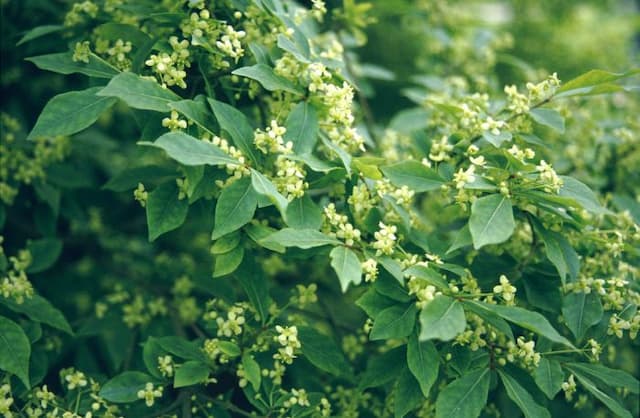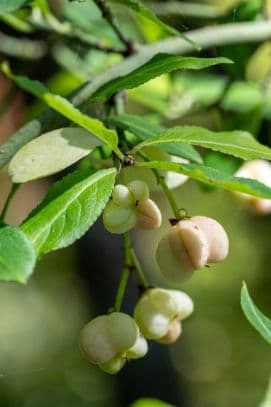Oriental Bittersweet Celastrus orbiculatus

ABOUT
The Oriental bittersweet is a deciduous, woody vine known for its ability to climb and trail over other vegetation and structures. It has alternate, glossy, round or oval leaves which are finely toothed. The leaves may change to a yellow color in the fall. This plant is well-known for its small greenish-white flowers, which are rather inconspicuous when compared to its fruit. The fruit appears as small round capsules that burst open to reveal bright red seeds encased within yellow husks. Oriental bittersweet is often recognized by these showy fruits, which are favored for decorative purposes, especially during the fall season. The vine itself can become quite thick as it matures, developing an extensive network of stems that may appear twisted and rope-like. The outer bark of the vine is usually a brown or gray color.
About this plant
 Names
NamesSynonyms
Oriental Bittersweet, Asian Bittersweet, Round-Leaved Bittersweet, Climbing Spindleberry.
Common names
Celastrus articulatus, Celastrus articulatus var. punctatus, Celastrus giraldii, Celastrus orbiculatus var. orbiculatus, Celastrus punctatus.
 Characteristics
CharacteristicsLife cycle
Perennials
Foliage type
Deciduous
Color of leaves
Green
Flower color
Greenish-yellow
Height
30 feet 9.14 meters
Spread
30 feet 9.14 meters
Plant type
Climber
Hardiness zones
4
Native area
Asia
Benefits
 General Benefits
General Benefits- Ornamental value: Celastrus orbiculatus, commonly known as the Oriental bittersweet, is often used in landscaping for its attractive, glossy green leaves and distinctive yellow-orange to red berries that provide visual interest, particularly in the autumn and winter months.
- Habitat for wildlife: The berries of the Oriental bittersweet provide a food source for a variety of bird species, which also help in seed dispersal.
- Erosion control: This plant's dense growth and extensive root system can help stabilize soil and control erosion on slopes and disturbed sites.
- Fast growth: Oriental bittersweet is known for its rapid growth and can quickly cover fences, trellises, and other structures, which can be beneficial for creating living screens or green coverings.
- Adaptability: It is highly adaptable to various soil types and environmental conditions, making it suitable for different landscapes.
 Medical Properties
Medical Properties- Antioxidant: Celastrus orbiculatus has been suggested to have antioxidant properties.
- Anti-inflammatory: The plant contains compounds that might be beneficial for reducing inflammation.
- Nootropic: There is some evidence that the seeds may enhance cognitive function.
- Antitumor: Extracts from the plant have shown potential antitumor activity in some studies.
 Air-purifying Qualities
Air-purifying QualitiesThis plant is not specifically known for air purifying qualities.
 Other Uses
Other Uses- Traditional Tool Making: The hard seeds of Celastrus orbiculatus, commonly known as Oriental bittersweet, were used by some Native American tribes to make beads and other handicrafts.
- Erosion Control: The plant's dense growth habit can stabilize soil and control erosion on slopes or disturbed areas, although its invasiveness needs to be managed.
- Fish Poison: Historically, some cultures have used the toxic compounds in the plant to stun fish, making them easier to catch.
- Ornamental Bonsai: The vine's ability to be trained into various shapes and its attractive features such as colorful berries can make it an unusual choice for bonsai.
- Live Fencing: When planted in rows, the vine can form a dense, impenetrable barrier that can serve as a living fence to delineate property boundaries or contain livestock.
- Support for Other Plants: Gardeners may use Oriental bittersweet as a natural support for other plants, though care must be taken so that it does not outcompete them.
- Habitat for Wildlife: The dense thickets created by the plant can provide shelter and nesting sites for certain species of birds and small animals.
- Art and Decoration: The vibrant berries and vines are sometimes used in floral arrangements, wreaths, and other decorative crafts, especially in the autumn.
- Soil Improvement: As a nitrogen-fixing plant, Oriental bittersweet can potentially improve soil fertility in degraded areas, although its aggressive growth often outweighs this benefit.
- Education and Research: The invasive nature and ecological impact of Oriental bittersweet make it a subject of study in ecology and environmental science education programs.
Interesting Facts
 Feng Shui
Feng ShuiThe Oriental bittersweet is not used in Feng Shui practice.
 Zodiac Sign Compitability
Zodiac Sign CompitabilityThe Oriental bittersweet is not used in astrology practice.
 Plant Symbolism
Plant Symbolism- Invasiveness: Celastrus orbiculatus, commonly known as Oriental bittersweet, is often symbolized as invasiveness due to its aggressive nature in ecosystems where it is considered an invasive species.
- Persistence: Oriental bittersweet is a symbol of persistence because of its tenacity and ability to thrive in diverse conditions, often outcompeting native plants.
- Resilience: The plant's ability to bounce back and adapt to various environments makes it a symbol of resilience.
- Domination: Reflective of its tendency to dominate and strangle trees and other plants, Oriental bittersweet symbolizes the idea of domination or control over one’s surroundings.
- Survival: Its capacity to survive in challenging circumstances symbolizes survival against adversity.
 Water
WaterThe Oriental bittersweet should be watered deeply and thoroughly, allowing the soil to slightly dry between waterings. You might need to water the plant once a week, providing about one to two gallons depending on the size of the plant and the weather conditions. During the growing season in spring and summer, it's essential to maintain consistent moisture but without waterlogging the soil. In winter, reduce watering frequency as the plant goes dormant and requires less water. Always check the top couple of inches of soil for dryness to gauge when it's time to water again.
 Light
LightOriental bittersweet thrives best in full sun to partial shade. For optimal growth, it should be planted in a spot that receives at least six hours of direct sunlight per day. However, it can also tolerate and adapt to lower light conditions, making it versatile for different garden locations. Ensure it is not placed in deep shade, as this may result in fewer flowers and weaker growth.
 Temperature
TemperatureOriental bittersweet is hardy and can tolerate a range of temperatures, from as low as -20°F to over 100°F. However, the ideal temperature range for promoting healthy growth is between 60°F and 85°F. It is a robust plant that can survive winter temperatures without much protection but ensure that it is not subjected to prolonged periods of extreme cold, which might damage the plant.
 Pruning
PruningPrune Oriental bittersweet to control its rapid growth and prevent it from becoming invasive. It's best to prune in late winter or early spring before new growth begins. Cut back any unwanted or overgrown vines and remove any dead or damaged sections to maintain the plant’s shape and health. Annual pruning is recommended, and for areas where Oriental bittersweet is considered invasive, more frequent pruning may be necessary to keep it under control.
 Cleaning
CleaningAs needed
 Soil
SoilOriental bittersweet thrives in a soil mix that is well-draining and rich in organic matter, with a preferred pH range of 6.0 to 7.5. A mix of loamy soil, compost, and perlite or sand facilitates good drainage and aeration, which is essential for healthy root development.
 Repotting
RepottingOriental bittersweet is a vigorously growing vine and may not require frequent repotting. It typically should be repotted every 2-3 years or when it becomes root-bound. Repotting in early spring is preferable before the new growth starts.
 Humidity & Misting
Humidity & MistingOriental bittersweet is tolerant of a wide range of humidity levels but prefers moderate humidity. Average room humidity is generally adequate for this plant, indicating it is not particularly demanding regarding atmospheric moisture.
 Suitable locations
Suitable locationsIndoor
Ensure bright, indirect light and support for climbing.
Outdoor
Plant in sun to partial shade, provide structure to climb on.
Hardiness zone
4-8 USDA
 Life cycle
Life cycleOriental bittersweet (Celastrus orbiculatus) begins its life cycle when seeds germinate in spring after experiencing a cold period to break dormancy. As seedlings emerge, they grow into vines that can climb or sprawl across the ground, rapidly outcompeting native vegetation. During the early summer through autumn, the plant produces small greenish-yellow flowers, which are dioecious, meaning male and female flowers grow on separate plants. Following pollination, typically by insects, female plants develop small, round, yellow orange to red fruits encasing seeds that are dispersed by animals and humans. These fruits can persist through winter, aiding in the spread of seeds. Oriental bittersweet can live for many years, forming dense infestations through vegetative reproduction by root suckering and layering, which can dominate ecosystems by girdling trees and altering habitats.
 Propogation
PropogationPropogation time
Spring-Early Summer
Propogation: Oriental bittersweet, scientifically known as Celastrus orbiculatus, is most commonly propagated through seed. The optimal time to collect seeds is in the fall, once the fruits have ripened to a yellow or red color. After collection, the seeds require a period of cold stratification to break dormancy; this can be achieved by mixing the seeds with slightly moist sand and storing them in a refrigerator for approximately two to three months. Once stratified, the seeds can be sown in pots filled with potting soil and lightly covered. They should be kept moist and will generally germinate in the spring. It's important to note that Oriental bittersweet is considered invasive in many regions, so its propagation may be discouraged or regulated.



![Spindle [Blondy]](/_next/image?url=https%3A%2F%2Fplants-admin.emdemapps.com%2Fimages%2Fplants%2F%2Fimages%2F604b642f54add.png&w=640&q=75)




